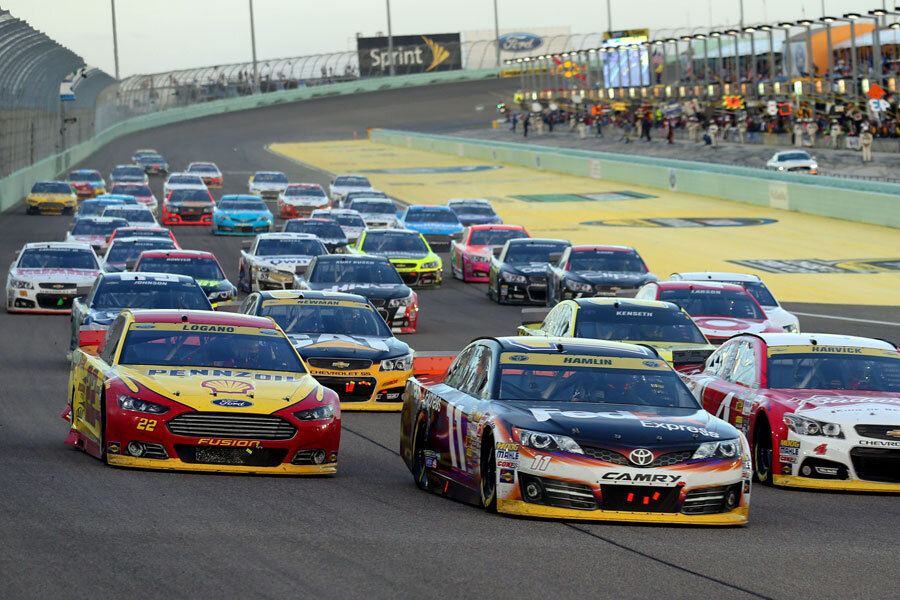Why should NASCAR go electric?
Loading...
NASCAR could change the world by racing electric cars, says Bill Nye the Science Guy in a blog post published Monday for Aeon.
“In the short term, NASCAR could help get us there. We could convert all of our racecars to electricity – right now – and show the public exactly what electrons can do,” Nye writes in the op-ed. “And most significant from my point of view, everyone in the crowd, every race fan, would want an electric car! The market for electric cars would go crazy.”
NASCAR should change its name to NESCAR, says Nye, which would stand for National Electric Stock Car Racing.
And Nye makes the argument that NASCAR would not be losing anything in the switch. While a current NASCAR race car can get up to 850 horsepower (hp), and a Tesla Model-S can only reach 532 hp, Nye insists that this difference is not discouraging – it is exciting. The 850 hp NASCAR racecar was intentionally designed for the track, but it is being compared with an electric sedan that any customer could buy right now in a showroom.
He argues the 300 horsepower difference is actually impressive.
“Just think what an electric carmaker, such as Tesla, could produce given, say, three years,” writes Nye.
And once the speed is competitive, Nye says electric race cars would offer other perks to NASCAR fans.
An electric racecar pit crew could complete its "refueling" in a fraction of the time, argues Nye. Instead of refueling a gas tank, crew members would simply press a button to drop out the old battery pack, and reload a fresh battery pack in its place.
The racetrack would also be quieter. Drivers could hear the clapping and cheering of their fans, and visitors would actually be able to talk to one another during the race.
“I’m telling’ ya, after you drive an electric car, you don’t want to drive anything else,” says Nye. “They’re faster, quieter and cheaper to operate.”
NASCAR’s all-electric race wouldn’t even be that novel, as Formula E racing welcomed its first season of electric car racing in 2014. And all of the criticisms about Nye's suggestion have been aired already by Formula 1 fans. But there are those who are excited about Formula E racing, including the billionaire British businessman Richard Branson:
Unless you have sports like this, we’ll never get to a world that’s carbon-neutral by 2050," he said. "I hope 10 years from now, 20 years from now, the smell of exhaust will be as much a thing of the past as the smell of cigarettes in a restaurant."
But Tom Jensen of Fox Sports notes several problems with Nye’s plan in an opinion article posted Wednesday.
For one, it would be expensive. Car owners have already invested in their vehicles and they are probably unwilling to invest in yet another large, upfront cost. There also is not great variety in the electric car market yet. For example, Chevrolet and Ford – two of NASCAR’s greatest investors – only have one electric model each.
Jensen also argues that NASCAR fans wouldn’t be interested in electric races.
“What excites and engages a scientist like Nye and a typical NASCAR race fan probably aren’t the same – not by a long shot,” he says. “Nor do I believe that taking the roar of engines away from the racing will be something that NASCAR fans would view as an upgrade.”
But environmental advocacy might not be as unnatural for NASCAR fans as Jensen suggests.
NASCAR has already taken several steps to be an environmental advocate through its NASCAR Green program. Through recycling and waste diversion efforts, NASCAR diverts 120,000 Goodyear tires from landfills each year. The organization Safety-Kleen provides its oil recycling services to over 200 NASCAR races a year, and since the beginning of their relationship, Safety-Kleen has collected enough discarded oil to power the Empire State Building for over a year.
And the companies Coca-Coca and Coors Light has partnered with NASCAR to recycle over 25 million bottles and cans at NASCAR tracks. Last year NASCAR started a pilot program at the Richmond International Raceway that either composted leftover racetrack food or donated it to the city’s hungry.
“Despite the excitement, NASCAR kinda breaks my heart,” Nye writes. “It’s a celebration of old tech. It uses gasoline-burning instead of electron-flowing…. I wish NASCAR were more about the future instead of the past.”
Nye says he wants NASCAR to fulfill his childhood expectations.
He says, “When I was a kid, auto-racing was where new technology was developed rather than where old technology was preserved or even celebrated.”








